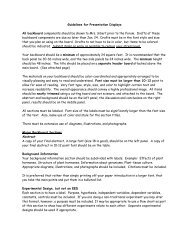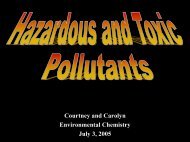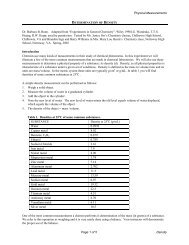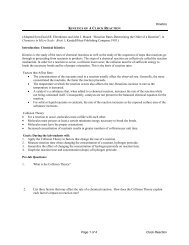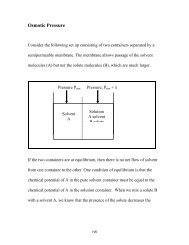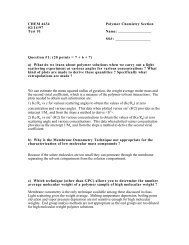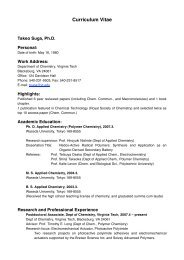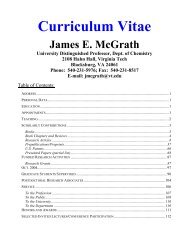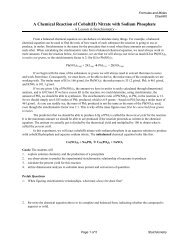Carlier Group Gaussian User Manual - Virginia Tech
Carlier Group Gaussian User Manual - Virginia Tech
Carlier Group Gaussian User Manual - Virginia Tech
Create successful ePaper yourself
Turn your PDF publications into a flip-book with our unique Google optimized e-Paper software.
<strong>Carlier</strong> <strong>Group</strong> <strong>Gaussian</strong> <strong>User</strong> <strong>Manual</strong> 47<br />
geometry and the force constants (note RCFC option in route section). Similarly, the<br />
forward IRC input file was constructed in the same way:<br />
%mem=4GB<br />
%scr=h0461<br />
%rwf=h0461<br />
%int=h0461<br />
%d2e=h0461<br />
%nosave<br />
%chk=h0461<br />
#b3lyp/6-31G(d) irc=(RCFC,forward,maxpoints=20,stepsize=10)<br />
geom=checkpoint<br />
IRC calc based on h0441 MeBr alkylation TS of concave enolate<br />
(simplified). geom from checkpoint<br />
-1 1<br />
Note that a priori one does not know which "way" a "forward" IRC calculation will<br />
proceed from the transition structure. However, in this case, the "forward" IRC<br />
calculation did go to the intended products.<br />
In my experience the most critical factor for success in IRC calculations is setting the<br />
step size. You have to play with this. If the step size is too big, I have seen at least two<br />
unwanted things happen<br />
1) you won't seem to progress along the reaction coordinate—this is confusing, because<br />
you will think you need to further increase the step size—which is tragically deceptive.<br />
2) when you further increase the step size, crazy stuff starts happening.<br />
For example, in the present case with a stepsize of 10, this IRC runs smoothly in the<br />
forward and reverse directions. With a stepsize of 50, this IRC runs only in the forward<br />
direction and the first point is UP in energy from the transition structure. It will not go<br />
anywhere productive in the backward direction with this large stepsize, even if the<br />
phase is specified (bond axis for movement). With a step size of 25, it runs in the<br />
forward direction, but again the energy of the first step is UP (not as much as when it<br />
was 50). In both the cases of 50 and 25, the forward IRC gets close to the product, but<br />
a vibrating behavior is seen and a stationary point is never reached. An attempt at<br />
running the backward IRC with a step size of 100 leads to a vibration, and an explosion.<br />
However, in the case of stepsize of 10, the forward and backward IRC go smoothly 20<br />
points towards the product and SM respectively, but never give the message "Minimum<br />
found." Nevertheless, both give a successful termination message.<br />
Thus although you may be successful at getting the IRC calclulations to proceed<br />
towards reactant and product, you may still not be successful at reaching your final<br />
destinations ("Minimum found"). Do not dismay. You must first assess how much<br />
progress you have made energetically, and to do this the easiest procedure is to take<br />
your points of furthest progress, save these geometries, and initiate geometry



